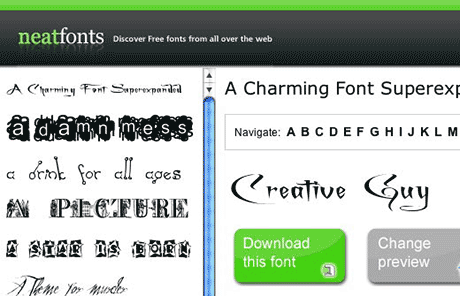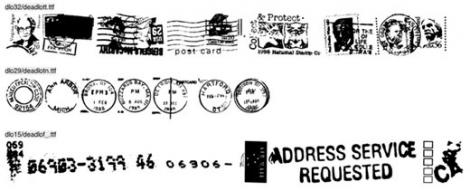 neatfonts has an exhaustive collection of fonts collected from all over the Web, organized and ready for you to download. From what I can tell, all the fonts are TrueType and .zip compressed for easy download.
neatfonts has an exhaustive collection of fonts collected from all over the Web, organized and ready for you to download. From what I can tell, all the fonts are TrueType and .zip compressed for easy download.
NeatFonts – cool free fonts and previewing
Quick jump between InDesign pages
Lets say you have a multi-page document and you’re jumping between two pages to see how text flows, etc. There’s an easier way than using the Command + J and number command. You can use the Command + Page Up/Page Down keys. For example, if you’re on page 2 and jump to page 8 normally, you can hit Command + Page Up to quickly go back to page 2 and then hit Commaned + Page Down to go back to page 8 again.
Using InDesign’s Absolute page numbers
If you’re working on a book or other document using InDesign’s Page Number and Section Options where page one is NOT the starting page in your numbering scheme, you’ve probably run into the problem where using the shortcut Command + J to jump to a specific page doesn’t take you where you want to go. For example, you have a 10 page document and you’ve set your automatic page numbering to actually start on the third page of the document. If you jump to page one, you actually end up on page three of the document, rather than the first page because the Command + J shortcut uses the Automatic Page Numbers as the guide to where to go. The simple workaround is to use the plus key. If you wanted to go to the first page in the document (not page one as it is numbered) you would hit Command + J then +1 – This tells InDesign to jump to the Absolute page in the document, in this case, the first page in the pages palette.
Free font: Dead Letter Office
 One of my favorite sites to visit is One Digital Life. It’s not really a “design” site, but it’s just fun to read and every once in a while he posts a real gem. About a week ago, I came across such a gem in a post titled Dead Letter Office Font. While the font is quite a unique font and not for everyday use, I actually was looking for something like it just when I came across the post.
One of my favorite sites to visit is One Digital Life. It’s not really a “design” site, but it’s just fun to read and every once in a while he posts a real gem. About a week ago, I came across such a gem in a post titled Dead Letter Office Font. While the font is quite a unique font and not for everyday use, I actually was looking for something like it just when I came across the post.
Getting smaller image sizes for Web design
You can achieve smaller file sizes for your jpeg photos for your Web site by blurring the image before saving. Use a slight Gaussian Blur on areas of the photo that aren’t important, such as a background or areas around the edge. A little bit of blur can go a long way to shrinking the file size.
Fade your healing brush results in Photoshop
If you’re using Photoshop’s Healing Brush, and the results are too dark for your taste, you don’t have to undo and start over, simply choose Edit>Fade Healing Brush and then lower the Opacity setting in the dialog box. The Fade menu item works on many tools and filters, so I encourage you to take a trip to the Fade menu item once in a while to see what you can do. Keep in mind that it only works on the last operation you made.
Changing the font size for PDF comments
To set the font and size of the text in an Acrobat Comment, choose Edit > Preferences > General (or hit Command + K) to open the Preferences dialog box. Once the dialog box is open, select Commenting from the list on the left. Choose the font size you wish from the pop-up menus. You can also set the opacity of the note boxes and the behavior of various types of comments while you’re there.


Does 9 to 5 = Average Designer?
The author of this article suggests that “balance” in your life leads to being an average designer. While I agree somewhat with the overall theory behind the article, I’m not sure my 20+ years of experience proves his theory correct. Being a designer requires a good work ethic and dedication. Being a great designer requires you to go the extra step. But what I’ve found is that you can stay late, work weekends and be as passionate as you can possibly be and there’s a very good chance you’re still going to be an average designer. Just like there’s a good chance that leaving the office at 5pm and having a well-rounded life outside the office will lead you to greatness. I subscribe to the theory that “I work to live, I do not live to work.” I think it makes me better at my job. Too many designers who make their career their entire life tend to make staying late and working weekends a badge of honor to be worn on their chest with pride. I consider it a badge of stupidity. Now don’t get me wrong, I think you have to be dedicated and willing to do whatever it takes to be great at your job… within reason. But just how great do you want to be? Just how great do you need to be? This is your career we’re talking about, not your life. Unless of course you let your design prowess define your life. Also remember that part of being a great designer (which is all about communicating with your targeted audience) is knowing the trends, interacting with people, visiting places and seeing “what’s out there.” You can’t do that sitting in your office, not matter how many free snacks are available or how many gadgets you have on your desk. As the owner of a design firm or ad agency, I would much prefer an office full of designers who rate a consistent 8 (on a scale of 1 to 10) who on occasion turn in work that makes them a 10 – rather than having an office full of 10s who get burnt out after 6 months and leave. I would rather have happy employees who look forward to coming to work each day and have life experiences to share. I do not want someone who has nothing to offer but their design, no passion beyond the work. This is a business about communicating with PEOPLE about their life. If you don’t have one of your own, it’s hard to speak to someone who does in a way that invokes passion.